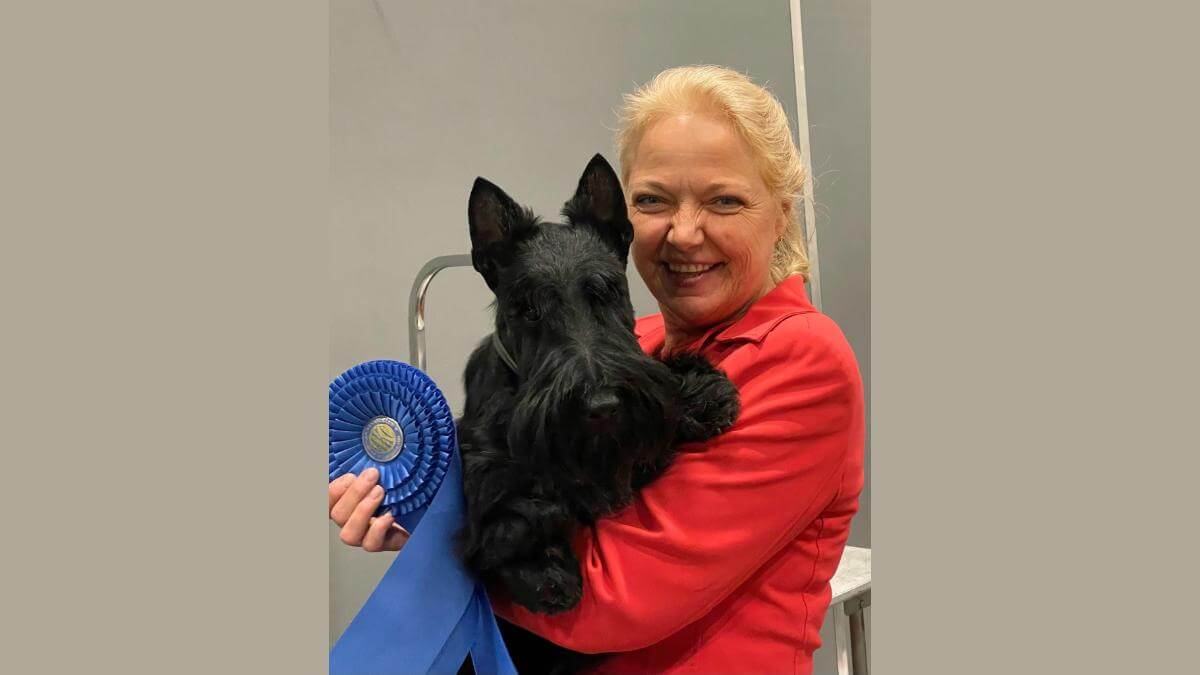
Home » Karen Prokopetz | Gyver Scottish Terriers

Karen Prokopetz
1. I am Karen Prokopetz and my husband, Gord, and I have owned and bred Gyver Scottish Terriers for more than 30 years. We are located in Regina, Saskatchewan, Canada, just north of Montana. We’ve typically bred a litter every two years, and this has continued in recent years, co-breeding with partners and with Taylor Oviatt, who I am mentoring. Fortunately, I was blessed with wonderful mentors, such as Darle Heck, inside and outside of Scotties, who took a real interest in me and understood the importance of paying it forward to the next generation.
2. The Scottish Terrier is a big dog in a small body; if you doubt it, just ask one. Seriously though, we feel so strongly about it that the Breed Standard calls for a compact, short-legged, sturdily-built dog of good bone and substance. Overall, there are nine references to strength, muscle, or power in the Standard, including: exemplifies power in a small package; the jaw should be square, level, and powerful; the neck should be strong, thick, and muscular; short, strong loin; deep flanks and very muscular hindquarters; broad, strong back; strong nails; the thighs should be very muscular and powerful for the size of the dog; with powerful drive from the rear, and he should exude ruggedness and power. In fact, to support that last excerpt, the Standard goes on to say that no judge should put to Winners or Best of Breed any Scottish Terrier not showing real terrier character in the ring.
At greatest risk is the Scottish Terrier front assembly. We are seeing dogs with straight shoulders and rotated fronts, creating a false forechest, being awarded over dogs with (per the Standard) shoulders which are well-laid-back, with forelegs set in under the shoulder blade with a definite forechest in front of them. Rotated fronts are not breed type. It’s our job as breeders and exhibitors to keep educating and bringing forward correct dogs.
3. As a Canadian, I checked in with the Scottish Terrier Club of America about this and they report that most breeders have waiting lists. Demand for Scotties remains strong, and responsible breeders are working hard to meet it without compromising quality. From my perspective, there is more to this than supply and demand. Generations grew up with Scotties and they still want to have a Scottie of their own, but for every home that is not able to have a Scottie, we lose another Scottie family. Over time, this cycle of families who want a Scottie but can’t get a Scottie will harm the popularity of our wonderful breed.
4. I’m pretty isolated where I live, so I’ve traveled to Montgomery County KC since 2002 to study dogs, and learn about type and trimming styles. More recently, social media has eased that isolation. It’s created opportunities for judges, breeders, exhibitors, and fanciers to connect, share, and support one another in ways that weren’t possible before.
5. There were a few years when many of the people in my neighborhood bragged about their rescues and doodles, but the tide has turned, and more and more I see lovely purebred pups on walks. I think purebred dogs are coming back into popularity and we, as breeders and exhibitors, should seize the moment to share their value with the public.
6. I’d like to draw attention to something that the CKC (Canadian Kennel Club) and the AKC (American Kennel Club) have been working with the CDC (Centers for Disease Control) to address. The new US import rule demands that dogs must be at least six months old at time of entry to the US. This new rule makes it impossible to effectively manage international breedings or the return of stud puppies to the US in a timely manner. The early socialization days of puppies are so important. I hope that this gets resolved soon.
7. There are many positive changes. Show results and points are now posted quickly online. Digital communication and social media have made it easier to share information. Online workshops and breed education are more accessible, giving judges, exhibitors, and breeders new ways to learn.